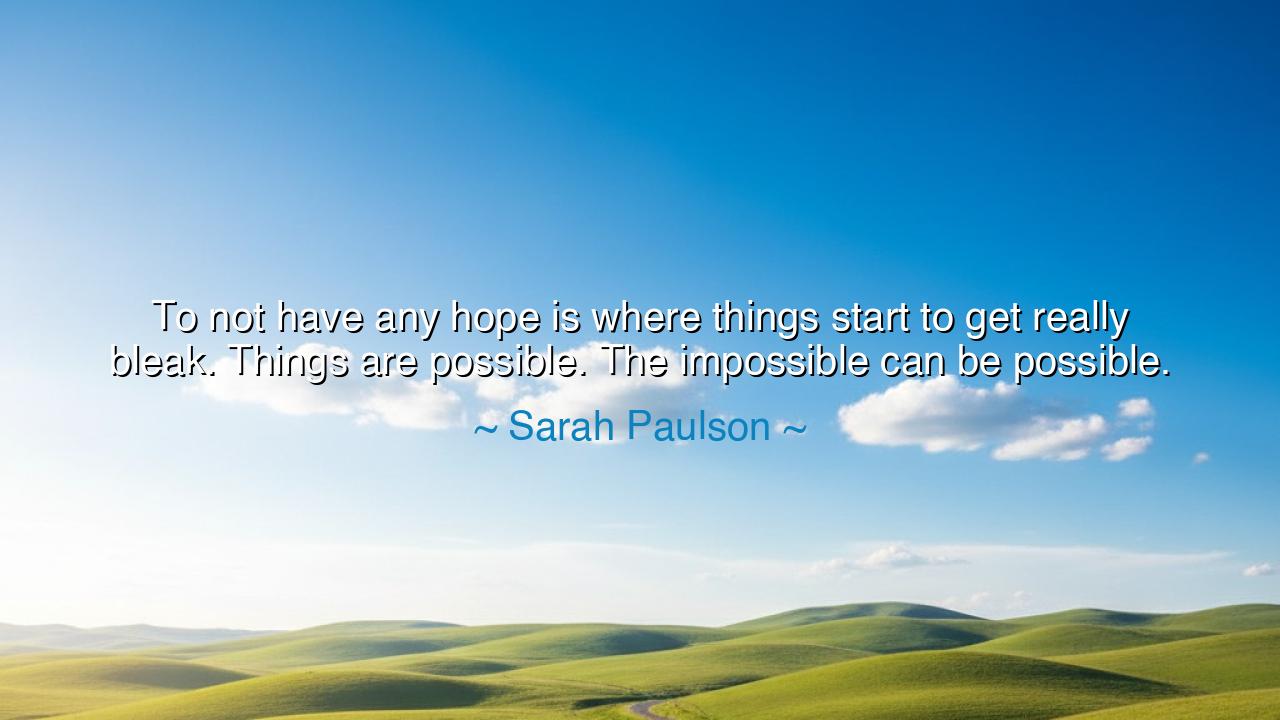
To not have any hope is where things start to get really bleak.
To not have any hope is where things start to get really bleak. Things are possible. The impossible can be possible.






When Sarah Paulson said, “To not have any hope is where things start to get really bleak. Things are possible. The impossible can be possible,” she spoke not only as an artist but as a seer of the human condition. Her words rise like a torch in the darkness, a reminder that even when life strips us of certainty, it cannot strip us of possibility. The tone of her declaration is not naive; it is hard-earned—a wisdom born from struggle, from the bruising path of self-discovery that every soul must walk. In her voice we hear the ancient truth that has echoed through the ages: that hope is the most defiant force in existence, the flame that outlasts despair, the seed that cracks stone.
Sarah Paulson, a woman of many roles and unyielding spirit, has often spoken about perseverance—about the storms endured by those who chase their art and their truth. Her quote reflects the lessons of one who has lived long enough to see how swiftly light can vanish, and yet how miraculously it can return. She reminds us that bleakness does not come from suffering itself, but from the absence of hope—from the moment when we stop believing that change is possible. For the human heart can endure pain, loss, and even failure, but it cannot live long without hope. When that flame dies, life becomes a hollow shell, and time becomes a burden rather than a gift.
The ancients would have recognized the truth in Paulson’s words. Hope—or elpis, as the Greeks called it—was considered both a divine blessing and a sacred trial. In Hesiod’s tale, when Pandora opened her fateful jar and released every evil into the world—disease, despair, hunger, and war—it was Hope that remained, shining softly at the bottom. Some said it lingered as comfort, others as temptation, but all agreed it was powerful. Even amidst the world’s ruin, hope refused to flee. And so it is with us: in the darkest hours of our lives, when all seems lost, hope does not abandon us—we abandon it. Yet if we reach for it, even faintly, the world begins to change shape, and what once seemed impossible starts to stir.
Consider the story of Helen Keller, born blind and deaf, imprisoned in a silence few could imagine. The world she lived in was for years without form, without voice, without promise. Yet within that void, she found a spark—a teacher’s hand, a single word traced upon her palm—and from that spark, an entire universe of understanding was born. It would have been easy for Helen to surrender to the bleakness of her condition, to say that nothing was possible. But she believed, as Paulson declares, that the impossible can be possible. Through perseverance and hope, she transcended every limitation placed upon her and became a beacon for generations, proving that even in total darkness, light can bloom.
To say “things are possible” is not a denial of struggle. It is an act of rebellion against despair. Hope does not promise an easy road—it promises a road worth walking. The heart that hopes learns to fight, to endure, to transform. In this sense, Paulson’s words are both tender and heroic: she calls upon us not to surrender when the world grows cold, but to remember that life is movement, and movement is possibility. Even when we do not see the way forward, hope is working quietly beneath the surface, preparing the soil for miracles.
Her words also remind us that the difference between the possible and the impossible is often measured by belief. Every invention, every act of creation, every revolution began first as a thought—a fragile seed of belief held by someone who refused to let it die. The Wright brothers believed that man could fly; Mandela believed that freedom could rise from chains; Paulson believes that even amid despair, there is light enough to live by. Each of these spirits shares the same truth: that hope is not a luxury, but a necessity, the very breath of the human soul.
So, my children of the living dawn, hear this ancient wisdom: do not let go of hope, no matter how fierce the night. When all else fades—when wealth is lost, when strength is gone, when friends turn away—cling to that quiet certainty that life still has more to offer. Whisper to yourself, as Sarah Paulson does, “Things are possible. The impossible can be possible.” And when the path ahead seems empty, light one small candle of belief and keep walking. For though the night may stretch long, the dawn always comes. And in that first glimmer of light, you will know that hope, once kept alive, can resurrect even the most impossible of dreams.






AAdministratorAdministrator
Welcome, honored guests. Please leave a comment, we will respond soon